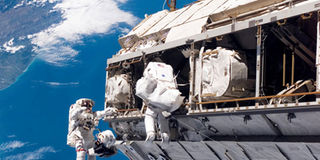Prime
Secondary students to study space science

Astronauts on a spaceship. The National Curriculum Development Centre has said it will integrate the study of earth and space science in the revised curriculum for secondary schools. PHOTO BY Agencies
What you need to know:
New age. The curriculum specialists say the knowledge will help students to discover new interests.
Kampala. The National Curriculum Development Centre (NCDC) has said it will integrate the study of earth and space science in the revised curriculum for secondary schools.
According to NCDC, introducing earth and space science studies early will incite the students to look for opportunities on other planets. Students will start with simple aspects and gradually delve into the complexities.
“The students should be able to discover new interests. We want to take advantage of the moon, space, earth and mercury,” Mr Mathias Mulumba, NCDC curriculum specialist, said.
“Some people are already thinking of going to live on the moon because the population is increasing rapidly on earth. We are looking for what life can be like on the moon and education reforms must find solutions to that,” Mr Mulumba explained.
Subjects reduced
The official told participants at a global education conference in Kampala at the weekend, which attracted educationists from Cameroon, Rwanda, Kenya and Europe, that the new curriculum will see the once 32 subjects taught at O-Level reduced to eight learning areas.
The symposium, organised by Educate Uganda focussed on how countries can help a teacher adjust to changes that are being introduced in the new curriculum to be rolled out in 2017.
Ms Sarah Kayondo, the Educate Country director said: “We believe that teachers are drivers of education. If you have to change the system, you have to involve them all the way. “If they do not get the skills needed in disseminating the new curriculum to the students, then stakeholders and the government’s efforts will all be in vain and we will continue to have many youth educated but with no jobs.” These eight learning centres will include Creative Arts, Languages, Religious Education, Science, Social Studies, Technology and Enterprise, Life Education and Mathematics. Earth and space is one of the six strands of Science.



